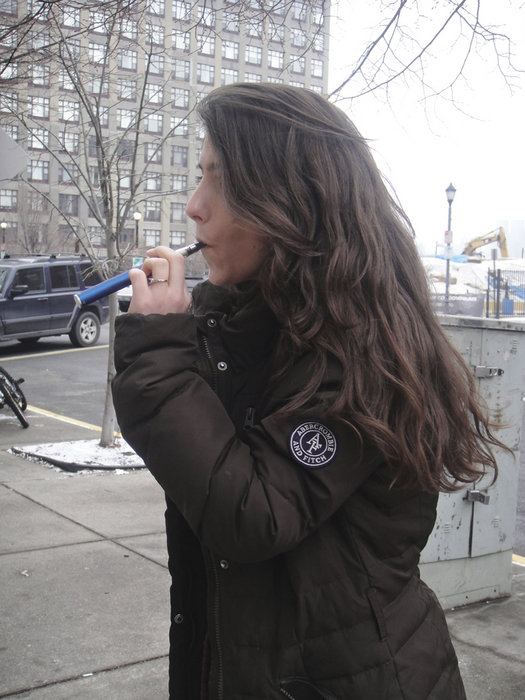Electronic cigarettes, e-cigs, are gaining in popularity among people trying to quit smoking. However, the U.S. Food and Drug Administration and doctors believe consumers don’t realize that e-cigs contain nicotine and other dangerous chemicals as well.
What is an electronic cigarette?
There are countless brands and flavors of e-cigs as companies try to broaden their appeal. They come in various shapes and forms, resembling an old fashioned cigarette, pens, USB flash drives, cigars, and pipes.
They are battery operated and turn nicotine and other chemicals and flavors into a vapor that consumers inhale. One of the known ingredients in e-cigs is propylene glycol, which is found in medical products and everyday items such as toothpaste and lotions.
Although e-cigs were introduced to the U.S. market in 2007, the first patent of a smokeless non-tobacco cigarette was obtained in 1963 by Herbert A. Gilbert. In 2003, the cigarettes became popular in China when pharmacist Hon Lik promoted them through his company, Ruyan, which means “resembling smoking.”
Banned
In 2009, the FDA began to stop shipments of electronic cigarettes from entering the country, requiring they be formally registered. The ban was later lifted, allowing shipments back into the U.S.
In 2010, former Gov. Jon Corzine signed into law a ban on electronic cigarettes in public places and workplaces. The ban also included e-cigarette sales to consumers 18 years of age and under. Children were a specific focus of the law because the various flavors and styles were meant to appeal to them.
“Since none of the e-cigarette products are currently regulated by the FDA, we really have no firm information about their safety.” – Dr. Michael Steinberg
____________
Several pro-electronic cigarette associations continue to dispute what they claim to be false claims by the FDA.
Transitioning
People hoping to quit smoking have turned to e-cigs with the belief that they offer less nicotine than the tobacco cigarette, a belief medical officials refute.
Alyssa Bredin from Hoboken has been a smoker for eight years and has now become an e-cig user. Bredin has been “vaping” for about a year now and could not be happier with the results, she said.
“I feel better; I don’t smell; and I can breathe easier,” she said. “My throat used to be so dry all the time when I would wake up. As far as I know [the only real ingredient] is nicotine, and nictotine is a stimulant and it’s not that bad for you, [unlike] the 50 million chemicals in cigarettes.”
Bredin’s mother, Terri Bish, also a Hoboken resident, also transitioned from tobacco cigarettes to e-cigs. Bish believes that the U.S. made e-cigs are far more safe than those from other countries.
“The American-grade nicotine goes to the standards, much like the patch, and you can mix your own,” said Bish. “Usually if you order [electronic cigarettes] from the United States it gives you the exact ingredients in the nicotine. The stuff coming out of China does not. My lungs cleared up; I don’t have that smoker’s cough when I get up in the morning; your nasal passages don’t feel dry; [there’s] no tar and crap all over my teeth anymore. It leaves no smell. For most heavy smokers, this has been a life saver.”
The trend has become so popular that last year, a store opened on Hoboken’s Washington Street exclusively selling e-cigs.
Not FDA approved
In 2009, the FDA established the Family Smoking Prevention and Tobacco Control Act to regulate tobacco-related diseases. According to the FDA, tobacco-related deaths kill more than 440,000 people per year.
The FDA has been striving to categorize e-cigs as a “tobacco product” which will make them subject to registration, product, and ingredient listing, among many other requirements. They have said that laboratory analysis from e-cig samples showed the products contained carcinogens as well as toxic chemicals such as diethylene glycol, an ingredient used in antifreeze.
After observing e-cig labels, the FDA concluded that cartridges claiming not to have nicotine actually do. The study also showed that similar e-cigs emit different varieties of nicotine.
Physcians fear the unknown about e-cigs.
“The e-cigarette is not regulated by the FDA,” said Medical Director Victor Marchione, M.D. of Liberty Health’s Smoking Cessation Program at Jersey City Medical Center. “Therefore you don’t really know what the ingredients are. You may indeed be playing with fire. In the United States, tobacco is not considered a drug. Nicotine is an ingredient in tobacco. Therefore they don’t have any jurisdication to regulate the e-cigarette at this time. There’s no way to ascertain what nicotine level you are trying to achieve.”
E-cigs have malfunctioned at times, which also poses a safety concern. A Florida resident was one of the victims of a faulty battery that exploded while in his mouth, causing him to lose his teeth and part of his tongue.
“There have been cases where people have been scarred or burned on the face from the device which has disintegrated in their hand,” said Marchione. “I tell [patients] it’s a dangerous device until it’s FDA approved by U.S. standards. I don’t recommend it at this time.”
Marchione said many of his patients invest in e-cigs without researching the product.
“Since none of the e-cigarette products are currently regulated by the FDA, we really have no firm information about their safety,” said Dr. Michael Steinberg, from UMDNJ-Robert Wood Johnson Medical School’s Tobacco Dependence Program in New Brunswick. “We don’t know for sure what other chemicals are contained in the vapor, and how much nicotine is delivered. The perception is that since they don’t contain smoke, they are safe.”
He added, “If [manufacturers] demonstrate that e-cigarettes were safe and effective, they would likely be much more warmly embraced by the medical and public health communities.”
The UMDNJ- Tobacco Dependence Program is currently in the process of conducting a study comparing the use of e-cigs and nicotine replacement medications. The results of the study will be available soon.
Vanessa Cruz can be reached at vcruz@hudsonreporter.com
